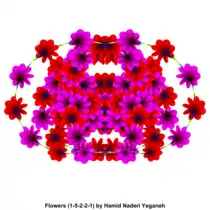Ayn al-Quzat Hamadani
Ayn-al-Qużāt Hamadānī, also spelled Ain-al Quzat Hamedani or ʿAyn-al Qudat Hamadhani (1098–1131) (Persian: عین القضات همدانی), full name: Abu’l-maʿālī ʿabdallāh Bin Abībakr Mohammad Mayānejī (Persian: ابوالمعالی عبدالله بن ابیبکر محمد میانجی), was a Persian[1][2][3] jurisconsult, mystic, philosopher, poet and mathematician who was executed at the age of 33.[4][5]
Title
Ayn-al-Qużat in Arabic means "the pearl of the judges": Ayn means the eye, implying something very valuable, and Qozat is the plural of Qadi, which means judge.
Life
He was born in Hamedan and his ancestors were of Hamedan judges. He was a disciple of Ahmad Ghazali and devoted of Hallaj. He became a famous scholar at early ages, and by the time he was thirty he was chosen judge. Along with Abu Hamed Al-Ghazali, he is one of the founders of doctrinal Sufism. According to some accounts, he was briefly a pupil of Omar Khayyam. Upon his return from pilgrimage, Khayyam likely stayed in Hamadan for some time. It is possible that during his stay he became tutor to the young Ain al-Quzat.[6]:351 However, Aminrazavi (2007) believes that from the figures who may have studied with Khayyam Ain al-Quzat is the least likely and that arguing their association is wishful thinking by those who like to view Khayyam as a Sufi.[6]:23 Unlike most of the Sufis who have lived as respected and revered members of their communities, he fell afoul of the Seljuk rulers and was accused of heresy and executed, either by crucifixion or burning.[7]:70
Ayn al-Quzat along with Mansur al-Hallaj and Shahab al-Din Suhrawardi are known as the three martyrs of Sufism.
Work
The most significant works of Ayn al-Qożāt are Tamhīdāt (تمهیدات; Preludes) and Zubdat al-ḥaqāʾiq fī kašf al-ḵalāʾeq (زبدة الحقائق في کشف الخلائق; The Essence of Truth). Both books are masterpieces of Sufi literature and have mystical and philosophical significance.[8] Ayn al-Qożāt Hamadānī quoted a few verses apparently in his own Iranian dialect (where it is called fahlavī; bayt-e pahlavī in a manuscript variant).[9]
Poetry
A famous quatrain is said to be his:
ما مرگ وشهادت از خدا خواسته ايم |
I want death and martyrdom from God |
This quatrain refers to his execution by Caliph's order.
Notes
- Hamid Dabashi, "Theology of discontent", Published by Transaction Publishers, 2006. pg 104: "..Ayn al-Qudat Hamadani, a twelfth century Persian mystic"
- Nadia Eboo Jamal, "Surviving the Mongols", I B Tauris & Co Ltd (May 23, 2003). pg 91: "At the same time, there was an opposite, more diffused, movement of some Ismaili ideas entering into Persian Sufism, as is evident, for instance, in the work of the mystical philosopher 'Ayn al-Qudat Hamadani, who was executed in 525/1131 by the Saljuqs
- Hellmut Ritter, John O'Kane, Bernd Radtke, "The ocean of the soul", Brill Academic Publishers (June 2003). excerpt from page 719: "'Ayn al-Qudat al-Hamadhani (Abu'l Ma'aali 'Abda Allah b. Muhammad Mayanji, Persian mystic, executed in Hamadan
- David Cook, Martyrdom in Islam. 2007. pg. 69
- AYN-AL-QOŻĀT HAMADĀNĪ in Encyclopedia Iranica by G. Böwering
- Mehdi Aminrazavi, The Wine of Wisdom: The Life, Poetry and Philosophy of Omar Khayyam, Oneworld Publications (2007)
- J. C. E. Bowen. (1973). The Rubāՙiyyāt of Omar Khayyam: A Critical Assessment of Robert Graves' and Omar Ali Shah's Translation. Iran, 11, 63-73.
- Hossein Nasr (2008), The Garden of Truth, New York, HarperOne
- Fahlaviyat in Encyclopedia Iranica by Dr. Ahmad Taffazoli Archived March 17, 2008, at the Wayback Machine
